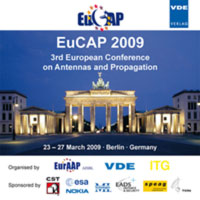Contoured-beam Reflectarray for DBS Application including Copolar Isolation Requirements between Missions
Conference: EuCAP 2009 - 3rd European Conference on Antennas and Propagation
03/23/2009 - 03/27/2009 at Berlin, Germany
Proceedings: EuCAP 2009
Pages: 5Language: englishTyp: PDF
Personal VDE Members are entitled to a 10% discount on this title
Authors:
Arrebola, Manuel (Electrical Engineering Department, Universidad de Oviedo, Edif. Polivalente (8.1.13), Campus de Viesques, 33203, Gijón, Spain)
Encinar, Jose A. (Electromagnetism and Circuit Theory Department, Universidad Politécnica de Madrid, E.T.S.I. Telecomunicación (B-414), Ciudad Universitaria s/n, 28040, Madrid, Spain)
Fuente, Luis F. de la (EADS-CASA Espacio, Avda. Aragón 404, 28022, Madrid, Spain)
Toso, Giovanni (Antenna and Sub-Millimeter Wave Section, Electromagnetics Division, European Space Agency, ESA ESTEC, Noordwijk, The Netherlands)
Abstract:
A reflectarray antenna designed to fulfil both coverage and isolation requirements of a commercial DBS mission with South American coverage (PAN-S) is presented. The PAN-S mission includes requirements for the coverage footprint and isolation with an European coverage (EUR). Both requirements have been used in the design process of a 1.2m reflectarray. In order to synthesize the radiation pattern, a phase-only algorithm based on the Intersection Approach technique is used. The isolation requirements are introduced by a suitable definition of the coverage areas and associated templates for maximum and minimum gain. As a result of the pattern synthesis, not only the compulsory isolation with EUR mission is achieved, but also isolation with North America coverage (PAN-N) can be significantly improved. After the pattern synthesis, a reflectarray made of 3 layers of varying-sized patches was designed, by optimising the dimensions of the patches to match the phase obtained from the synthesis for dual-linear polarisation at several frequencies in Tx (11.7-12.2 GHz) and Rx (13.75-14.25 GHz) bands. The results show that the coverage requirements are always fulfilled in more than 90% of the surface in each zone for TX and RX bands.


